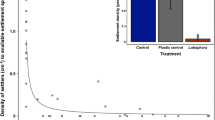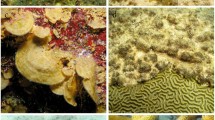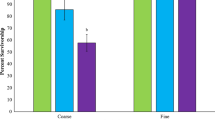Abstract
Sedimentation is assumed to affect communities of reef-building corals by inhibiting larval settlement, however there has been no quantitative evidence to support this supposition. The effects of varying rates of sedimentation (0.5 to 325 mg cm-2d-1) on settlement rates of Acropora millepora larvae were examined experimentally, in aquaria. Settlement and juvenile orientation onto conditioned cut coral plates were recorded after two days. Higher sedimentation rates reduced the number of larvae settling on uppersurfaces, but total numbers of settled larvae were not significantly affected by sedimentary regime. While total settlement was unaffected by sediment under the confined experimental conditions, it is likely to be reduced under field conditions, since accumulation of sediment on upward-facing surfaces will greatly reduce the overall amount of suitable substratum available.
Similar content being viewed by others
References
Aller RC, Dodge RE (1974) Animal-sediment relations in a tropical lagoon Discovery Bay, Jamaica. J Mar Res 32:209–232
Babcock RC (1985) Growth and mortality in juvenile corals (Goniastrea, Platygyra and Acropora): the first year. Proc 5th Int Coral Reef Symp 4:355–360
Babcock RC (1986) Population biology of reef flat corals of the family Faviidae (Goniastrea, Platygyra). PhD thesis, Department of Marine Biology, James Cook University, Townsville
Bak RPM (1978) Lethal and sublethal effects of dredging on coral reefs. Mar Pollut Bull 9:14–16
Bak RPM, Engels MS (1979) Distribution, abundance and survival of juvenile hermatypic corals (scleractinia) and the importance of life history strategies in the parent coral community. Mar Biol 54:341–352
Birkeland C (1977) The importance of rate of biomass accumulation in early successional stages of benthic communities to the survival of coral recruits. Proc 3rd Int Coral Reef Symp 1:15–21
Birkeland C, Rowley D, Randall RH (1981) Coral recruitment patterns at Guam. Proc 4th Int Coral Reef Symp 2:339–344
Carleton JH, Sammarco PW (1987) Effects of substratum irregularity on success of coral settlement: quantification by comparative geomorphological techniques. Bull Mar Sci 40:85–98
Cortes JN, Risk MJ (1985) A reef under siltation stress: Cahuita, Costa Rica. Bull Mar Sci 36:339–356
Edmondson CH (1928) The ecology of an Hawaiian coral reef. Bull Bernice P Bishop Mus 45, 64 pp
Fisk DA, Harriott VJ (1989) The effects of increased sedimentation on the recruitment and population dynamics of juvenile corals at Cape Tribulation, North Queensland. Great Barrier Reef Marine Park Authority Tech Mem 33 pp
Harrigan J (1972) The planula larva of Pocillopora damicornis: lunar periodicity of swarming and substratum selection behaviour. PhD thesis, University of Hawaii
Harriott VJ (1983) Reproductive seasonality, settlement and post-settlement mortality of Pocillopora damicornis (Linnaeus), at Lizard Island, Great Barrier Reef. Coral Reefs 2:151–157
Harriott VJ (1985) Recruitment patterns of scleractinian corals at Lizard Island, Great Barrier Reef. Proc 5th Int Coral Reef Symp 4:367–372
Harriott VJ, Fisk DA (1988) Recruitment patterns of scleractinian corals: a study of three reefs. Aust J Mar Freshwater Res 39:409–416
Hoyal DCJD (1986) The effect of disturbed rainforest catchments on sedimentation in an area of nearshore fringing reef: Cape Tribulation, North Queensland. Hons Thesis, Department of Geography, James Cook University, Townsville
Hughes TP (1985) Life histories and population dynamics of early successional corals. Proc 5th Int Coral Reef Symp 4:101–106
Lewis JB (1974) The settlement behaviour of planulae larvae of the hermatypic coral Favia fragum (Esper). J Exp Mar Biol Ecol 15:165–172
Marshall SM, Orr AP (1931) Sedimentation on Lowe Isles Reef and its relation to coral growth. Scient Rep Gt Barrier Reef Exped 1:94–133
Neudecker S (1981) Effects of substratum orientation, depth and time on coral recruitment at Guam. Proc 4th Int Coral Reef Symp 2:376 (abstr)
Oakley SG (1988) Settlement and growth of Antipathes pennacea on a shipwreck. Coral Reefs 7:77–79
Pastorok RA, Bilyard GR (1985) Effects of sewage pollution on coral-reef communities. Mar Ecol Prog Ser 21:175–189
Peters EC, Pilson MEQ (1985) A comparative study of the effects of sedimentation on symbiotic and asymbiotic colonies of the coral Astrangia danae (Milne-Edwards and Haime 1849). J Exp Mar Biol Ecol 92:215–230
Pillai CSG (1971) Composition of the coral fauna of the southeastern coast of India and the Laccadives. Symp Zool Soc Lond 28:301–327
Porter JW (1972) Patterns of species diversity in Caribbean reef corals. Ecology 53:745–748
Rogers CS (1983) Sublethal and lethal effects of sediments applied to common Caribbean reef corals in the field. Mar Pollut Bull 14:378–382
Rogers CS, Fitz HC III, Gilnack M, Beets J, Hardin J (1984) Scleractinian coral recruitment patterns at Salt River submarine canyon, St. Croix, US Virgin Islands. Coral Reefs 3:69–76
Rogers CS (1983) Sublethal and lethal effects of sediments applied to common Caribbean reef corals in the field. Mar Pollut Bull 14:378–382
Sammarco PW (1980) Diadema and its relationship to coral spat mortality: grazing, competition and biological disturbance. J Exp Mar Biol Ecol 45:245–272
Sato M (1985) Mortality and growth of juvenile coral Pocillopora damicornis (Linnaeus). Coral Reefs 4:27–33
Veron JEN, Wallace CC (1984) Scleractinia of eastern Australia. Part V. Family Acroporidae. Australian Institute of Marine Science, Townsville, 485 pp
Wallace CC (1985) Seasonal peaks and annual fluctuations in recruitment of juvenile scleractinian corals. Mar Ecol Prog Ser 21:289–298
Wallace CC, Bull GD (1981) Patterns of juvenile coral recruitment on a reef front during a spring-summer spawning period. Proc 4th Int Coral Reef Symp 2:344–350
Author information
Authors and Affiliations
Rights and permissions
About this article
Cite this article
Babcock, R., Davies, P. Effects of sedimentation on settlement of Acropora millepora . Coral Reefs 9, 205–208 (1991). https://doi.org/10.1007/BF00290423
Accepted:
Issue Date:
DOI: https://doi.org/10.1007/BF00290423




